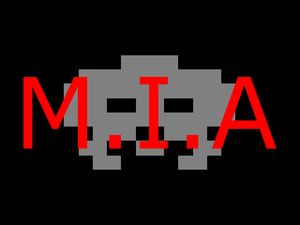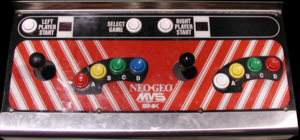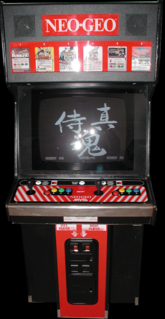Lost In Translation/Samurai Shodown V
| Samurai Shodown V | |
|---|---|
| Manufacturer | Yuki Enterprise / SNK Playmore |
| Released | 2003 |
| Control Method |
8-way Joystick 4 Button(s) |
| Main CPU | Neo-Geo 68000 (@ 12.000 MHz) Z80 (@ 4.000 MHz) |
| Sound CPU | Stereo YM2610 (@ 8.000 MHz) |
| Video Details |
Raster (Horizontal) 320 x 224 pixels 59.19 Hz 4,096 Palette colours |
| Screens | 1 |
| ROM Info | 25 ROMs 94,437,376 bytes (90.06 MiB) |
| MAME ID | samsho5 · samsho5b · samsho5h |
About The Game
Samurai Shodown V is a one-on-one fighting, weapon-based arcade video game, featuring 24 selectable characters, plus Poppy (secret character), plus 3 bosses (Sankuro the mid-boss, Yumeji the sub-boss and the general Gaoh as final boss).
Additional Technical Information
Players : 2
Control : 8-way Joystick
Buttons : 4
=> [A] Light attack, [B] Medium attack, [C] Kick/Break defence, [D] Lie down/Forward roll/Back roll/Small jump/Dodge
Trivia
Released in October 2003.
This game is known in Japan as "Samurai Spirits Zero" since the story takes place before the first Samurai Spirits episode.
Parts of Shiki's personality are homages to Rei Ayanami (a character from Evangelion) and Mugen no Jyuunin. As a matter of fact, one of her win-quotes was taken word-for-word from a quote in Evangelion.
Rera first appeared in a Nakoruru OVA titled 'Nakoruru - Ano hito kara no okurimono'.
Sankuro's name and moves (which call out his henchmen), collectively, contain all the digits from one to nine.
Yumeji's attacks are all borrowed from other characters (for most of them, she morphs into the character she is borrowing the move from). Her Shin Musou Ittou-ryuu Kagerou and Shin Musou Ittou-ryuu Sasame Yuki - Sen are all borrowed from Ukyo's Bust moves in SS4 (Ukyo only has his Slash moves from SS4 in SS5). She also borrows : Charlotte's Bayonette Lunge, Genjuro's Sanren Satsu, Hanzo's Ninpou Mozu Otoshi, Haohmaru's Ougi - Kogetsu Zan, Jubei's Yagyu Shingan Tou - Souha, Kyoshiro's Choubi Jishi, Nakoruru's Annu Mutsube, Rimururu's Rupush Kamui Weison Pekoru, Ukyo's Hiken Tsubame Gaeshi, Yoshitora's Yon no Tachi - Tsubaki.
The creator of the manga 'Rurouni Kenshin', Nobuhiro Watsuki, helped to make 'Yoshitora Tokugawa'. Nobuhiro Watsuki has declared many times his love for the Samurai Spirits video-games. You can find some characters in his work strictly copied from these series.
Card game : In December 2006, Sabertooth Games released a Samurai Shodown V collectable card game set for it's Universal Fighting System (UFS) game.
Updates
If you put the game in 'Japan territory' via the MVS bios setting, the story mode will be completed by little scenes of dialogues between the different characters.
Tips and tricks
Costume Colour Select
Everyone has four outfit colours chosen by A, B, C or D. The (D) button ones seem to be the oddest ones.
Play As Poppy
On the character select screen highlight 'Kazuki' and then move Left, Right, Left(x2), Right(x2), Left(x2), Right and then button A to select (use buttons B to D instead for different colours).
I'm Not Afraid Of You!
Think you are really good? Tap Start 3 times quickly to make your character drop his/her sword. Now show your opponents that the most fearsome weapons are the ones you were born with!
Secret Win Pose
If you get a Perfect win in the second round with Galford, one of Poppy's puppies will show up and run forward, only to stumble and land on it's stomach.
Pursuit Reset
Pick Jubei and perform a Big Pursuit when unarmed (press Up+B+C when your opponent is down). The game will reset.
Series
- Samurai Shodown (1993)
- Samurai Shodown II (1994)
- Samurai Shodown III (1995)
- Samurai Shodown IV - Amakusa's Revenge (1996)
- Samurai Shodown 64 (1997)
- Samurai Shodown 64 - Warrior's Rage (1998)
- Samurai Shodown V (2003)
- Samurai Shodown V Special (2004)
- Samurai Shodown - Tenkaichi Kenkakuden (2005)
- Samurai Shodown - Edge of Destiny (2008)
Staff
- Illustrators
- Dorio Takaya
- Takkun
- Sakuraitohru
- Murasaki
- Yukikage
- Takahashi
- Character Designers
- Nobuhiro Watsuki
- Takuro Fuse
- Ponkichi
- Kentaro Maruta
- Gunpom
- C. Takahashi
- Qon
- Yuichi Nakatani
- Shinosuke
- Kusarehada
- Takayanagi K'
- Takaomi
- Shuhei Hayashi
- Kano Toyo
- Tomisu
- Toshirou Hara
- Taisuke Satoh
- Yasuhiro Nightow
- Daisuke Shimada
- Morita Kazuro
- Ken
- Hide. H
- M. Kawamura
- Nakamura Yoshihiro
- [Marehen Breaker]
- Kazuhiro Mikuma
- Kengo Tanaka
- [Tachyon]
- Miyazaki-Atu
- [Mechanic Arms]
- Manabu Sakai
- Yoshiki Oyabu
- Toshiharu Tagami
- Music Compose
- Suemura Kennosuke
- Kuroiwa Haruhiko
- Arrange & Sound Design
- Suemura Kennosuke
- Sound Effect
- Miyazaki Seiji
- Sound Director
- Matsuo Atsuya
- Hide. H
- Producer
- Yasuo Tanaka
Voice Actors
- Announcer/Narrator
- Satoshi Taki
- Haohmaru
- Masaki Usui
- Nakoruru
- Harumi Ikoma
- Yoshitora Tokugawa
- Hiro Yuki
- Mina Majikina
- Satsuki Yukino
- Ukyo Tachibana
- Eiji Yano
- Rimururu
- Hitomi Nabatame
- Yunfei
- Satoshi Taki
- Kusaregedo The Demon
- Go Shinomiya
- Genjuro Kibagami
- Kong Kuwata
- Rera
- Kyoko Hikami
- Kyoshiro Senryo
- Monster Maetsuka
- Rasetsumaru
- Tsuguo Nakajima (formerly Mogami)
- Kazuki Kazama
- Atsushi Yamanishi
- Sogetsu Kazama
- Naoki Oikawa
- Enja
- Shintarou Ohata
- Suija
- Ikouji Nose
- Hanzo Hattori
- Toshimitsu Arai
- Galford
- Mantaro Koichi
- Shizumaru Hisame
- Miho Kaneda
- Jubei Yagyu
- Kiyoshi Kobayashi
- Basara
- Masahiro Nonaka
- Gaira Caffeine
- Takeshi Watanabe
- Charlotte
- Harumi Ikoma
- Tam Tam
- Toshikazu Nishimura
- Sankuro Yorozu
- Tomoyuki Shimura
- Yumeji Kurokouchi
- Mitsuki Saiga
- Gaoh Kyougoku Hinowanokami
- Kenji Utsumi
Cabinet and Artwork
Ports
- Consoles
- Sony PlayStation 2 (2004)
- Microsoft XBOX (2005)
Soundtrack Releases
| Album Name | Catalogue No. | Released | Publisher | Comments |
|---|---|---|---|---|
| Onban Samurai Spirits Tenkaichi Kenkyakuden - Zero no Maki | SCDC-00538~40[1] | 2006-08-09 | Happinet Corporation | 3 CD version. |





